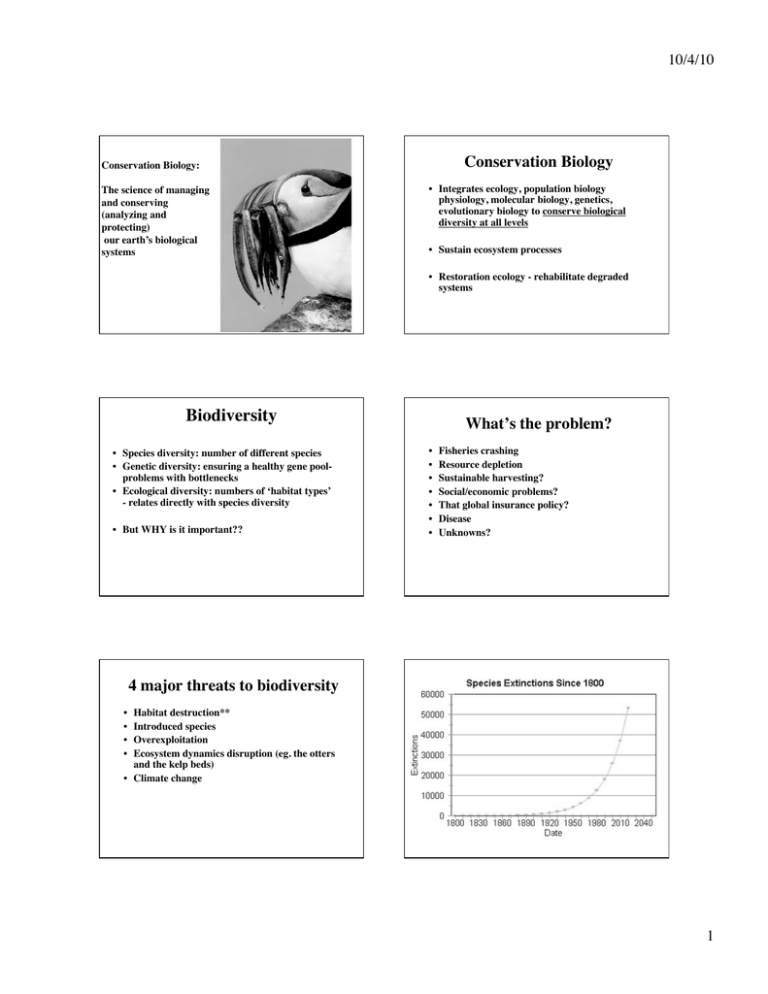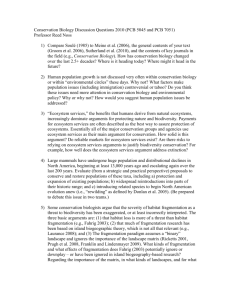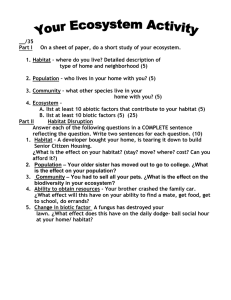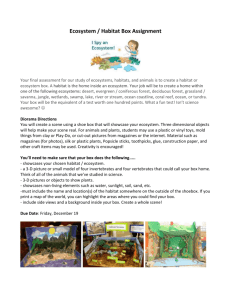Document 13036501
advertisement

10/4/10 Conservation Biology Conservation Biology: The science of managing and conserving (analyzing and protecting) our earth’s biological systems • Integrates ecology, population biology physiology, molecular biology, genetics, evolutionary biology to conserve biological diversity at all levels • Sustain ecosystem processes • Restoration ecology - rehabilitate degraded systems Biodiversity • Species diversity: number of different species • Genetic diversity: ensuring a healthy gene poolproblems with bottlenecks • Ecological diversity: numbers of ‘habitat types’ - relates directly with species diversity • But WHY is it important?? What’s the problem? • • • • • • • Fisheries crashing Resource depletion Sustainable harvesting? Social/economic problems? That global insurance policy? Disease Unknowns? 4 major threats to biodiversity • • • • Habitat destruction** Introduced species Overexploitation Ecosystem dynamics disruption (eg. the otters and the kelp beds) • Climate change 1 10/4/10 Treaties and Laws Endangered Species Act (1973) • protect critically imperiled species from extinction as a "consequence of economic growth and development untendered by adequate concern and conservation.” Treaties and Laws • Marine mammal Protection act (1972) • Prohibits marine mammal ‘take’ with exceptions • IWC: 1946, 1986, a treaty, under the ICRW • Endangered vrs. Threatened and ‘candidate species’ • Critical habitat: Critical habitats are required to contain "all areas essential to the conservation" of the target species (Section 3(5) (A)). Such lands may be private or public. Treaties and Laws • The International Union for Conservation of Nature and Natural Resources IUCN: 1948, an organization • Led to the Convention on International Trade in Endangered Species of Wild Fauna and Flora CITES (1973), a Treaty. One of the largest conservation agreements in existence – International Convention for the Regulation of Whaling Island Conservation: a science based approach to management the case of the burros on the loose http://www.islandconservation.org - Introduced Mammals Habitat fragmentation Habitat fragmentation is the separation of a landscape into various land-uses (e.g, development, agriculture, etc.), resulting in numerous small, disjunct habitat patches left for use by wildlife. Effects on: • Migratory animals • Animals with large territories • Resource availability • Ecosystem stability Habitat fragmentation: The Buenos Aires National Wildlife Refuge in Arizona on the Mexican boarder Fence Removal The Refuge is removing or altering barbed wire fences left over from ranching days. This aids the movement of deer and pronghorn. Many volunteers and wildlife organizations assist the refuge in many of the fence removal projects. 2 10/4/10 Habitat fragmentation: The Buenos Aires National Wildlife Refuge in Arizona on the Mexican boarder Migration corridors Refuge land traded for border fence Buenos Aires to give up 5.8 acres; deal upsets environmental group By Arthur H. Rotstein THE Associated Press Tucson, Arizona | Published: 11.10.2007 Nearly a mile of national wildlife refuge borderland near Sasabe will be traded to allow completion of border fencing, federal agencies announced Friday. It drew criticism from an environmental group.The Department of Homeland Security will acquire 5.8 acres along the border now part of the Buenos Aires National Wildlife Refuge. It needs the land to complete a seven-mile stretch of fencing to slow illegal immigration there. The short-tailed albatross: species approach Approaches to conservation biology • Species approach – Managing for a species, eg. one in critical status: Pandas, California Condors – Breeding programs • Population approach – Managing for individual populations, not an entire species. Eg. Elephants – Relocation programs • Ecosystem approach – Managing for an interconnected system to preserve diversity The California Condor: species approach Condor history • • • • • • • • • • • 1924 last sighting of condor in Arizona 1926 captive condor - infertile eggs 1952: San Diego capture and breed condors 1953 first legal protection 1965 - 60 birds left in the wild 1967 - listed as endangered 1983 - first eggs hatched in captivity 1992-first wild release 1993-5 wild condors (of 72) 2006 - second fledged in the wild! 2007 - 2 eggs hatched at SD zoo - one released back to parents 3 10/4/10 Condor recovery • • • • • • • • • Condor sanctuaries and protected areas: corridors? Monitor causes of death (lead) Education Captive breeding programs** Radio-tagging for monitoring Control poaching Federal listing and State listing as ‘endangered’: legal protection Research: life history, behavior Translocation Tuna, Manta Rays - a population approach? • Population level management: ESUs or Evolutionarily Significant Units • Identify populations (units) that need protection • Develop and implement plans Steelhead: Onchorhynchus mykiss Yellowfin Tuna - tag data www.TOPP.org African Elephants Ecosystem Approach • IUCN - world conservation union: • History of • severe poaching and habitat Population Approach fragmentation • Establishment of protected areas left some populations expanding and others still in trouble • Manage populations separately • Complex social systems • Translocation programs • Induced sterility • Culling • The Ecosystem Approach places human needs at the centre of biodiversity management. It aims to manage the ecosystem, based on the multiple functions that ecosystems perform and the multiple uses that are made of these functions. The ecosystem approach does not aim for short-term economic gains, but aims to optimize the use of an ecosystem without damaging it. 4 10/4/10 Figure 55.14 The zoned reserve concept of landscape management Management approaches • Landscape and regional conservation – Sustaining biotas - look at past and present patterns • Habitat fragmentation – Corridors – Metapopulations/subpopulations • Establishing protected areas - not an easy process! – Eg. marine reserves – Multiple use? – Zoned reserves West Coast Marine Managed Areas (MMAs) at a Glance • 269 MMAs exist in west coast waters (0 - 200 m). • These MMAs cover nearly half (47%) the west coast waters. • Almost this entire area (99.9%) allows multiple uses, such as fishing and recreation. • A small fraction of the MMA area (0.1%) is no-take. • Federal MMAs are fewer, but much larger than state MMAs. • Fishing is allowed in almost the entire MMA area (99.9%).・ ・ ・ ・ ・ Marine Protected Areas • The official federal definition of an MPA is: any area of the marine environment that has been reserved by federal, state, tribal, territorial, or local laws or regulations to provide lasting protection for part or all of the natural and cultural resources therein. Executive Order 13158 (May 2000) Marine Protected Areas classification • – Natural Heritage – Cultural Heritage – Sustainable Production • • Multiple use! - less than 1% are ‘no take’ • Designed to set aside critical habitat to ensure ‘breeding stock’ to ‘feed’ the fishery - no use or ‘rotational’ use • Designed for territorial or non-migratory organisms (a) Conservation Focus (one or more) • • • A management strategy to help sustain fisheries • (b) Level of Protection Afforded (one attribute) – Uniform Multiple-Use – Zoned Multiple-Use Zoned with No-Take Area(s) – No Take – No Impact No Access (c) Permanence of Protection (one attribute) – Permanent – Conditional – Temporary (d) Constancy of Protection (one attribute) – Year-round – Seasonal – Rotating (e) Ecological Scale of Protection (one atrribute) – Ecosystem – Focal Resource 5 10/4/10 Species Approach Case Study: The Asian Elephant Management Protected areas: The Convention on Biological Diversity defines protected areas as:・ "a geographically defined area which is designated or regulated and managed to achieve specific conservation objectives.” IUCN the world conservation union defines protected areas as:・"areas of land and/or sea especially dedicated to the protection and maintenance of biological diversity, and of natural and associated cultural resources, and managed through legal or other effective means." • • • • • • • • • • • • Elephant and wildlife corridor between park and sanctuary Manage human/elephant conflict (elephant deterrents Education Use domesticated Elephants to help protect Radio-tagging elephants outside of protected areas Control poaching Restore landscapes for elephants Ecotourism ($$) Breeding Monitoring populations Research: life history, behavior Translocation And YOU own this one - make good informed decisions about it! 6







